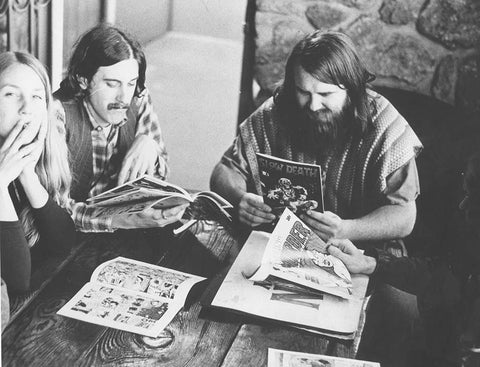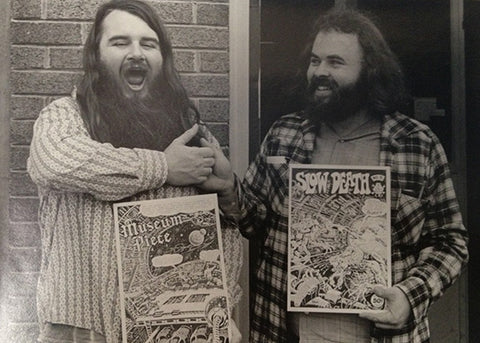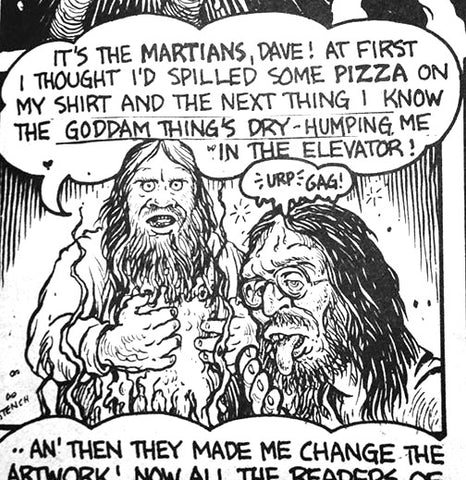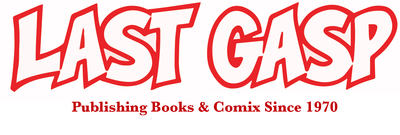The Origins of Last Gasp
Last Gasp is one of the largest and oldest publishers and purveyors of underground comic books in the world, as well as being a distributor of all sorts of weird 'n' wonderful subversive literature, graphic novels, tattoo and art books. If you ever wondered how such an institution first came into existence, read on...
Once upon a time at a Christmas or New Year's party in the Berkeley hills almost thirty years ago, someone handed a very stoned graduate psychology student a copy of ZAP™ Comix and rekindled a forgotten love of comic books. "I remember reading it and remarking how close it came to the heightened mind-experience one got when stoned," recalls Ron Turner, owner and founder of Last Gasp. "It brought back all my love of comics, but in an adult form that I could appreciate. I went into the back room and started reading the damn thing over and over".

Ron Turner with Slow Death comic book, an early Last Gasp publication.
The late sixties was a tumultuous time. Ron was attending San Francisco State University, and the Vietnam war was at its height. The student body was on strike and clashes between the five thousand daily protesters and the one thousand police officers present on campus were not an uncommon occurrence. "(During the strike) we'd regroup at night in someone's apartment and I'd always bring along a lot of comic books," he remembers. "...and what I liked was that everyone found them universally entertaining in some light. The early feminists found the books funny, ...the Panthers, and the black student union guys cracked up very much at Gilbert Shelton's depiction of Watermelon Jones. Angelfood McSpade by Crumb is considered to be a satire - no-one felt that anything was aimed at them. It was the satire they were enjoying, not (that they were) the target of bad humor. So that impressed me , (that) the cartoonists had such a good sense of things."
Around this time, Ron moved to Berkeley and became involved with some people who had started an ecology center, the first of its kind in the country. In a bid to raise funds for the center, as well as to increase awareness of what was going on in the world with regards to politics and ecology, he borrowed $2,500 from a friend and published the first issue of Slow Death Funnies as a benefit book. The comic book included work by Gilbert Shelton (of Fabulous Furry Freak Brothers fame) and R.Crumb's Mr Natural and Flaky Foont in Smogville Blues. "Greg Irons did the cover" he remembers. "He depicted a monster earth with all the corporations rising out of its hair. We had just landed on the moon, and he drew this one big claw reaching out and touching the moon. I thought that was great!" Slow Death Funnies #1 came out on the first "Earth Day", April 15 1970 and was received enthusiastically at campuses all over the Bay Area. Unfortunately however, when Ron arrived at the Ecology Center with the twenty thousand copies of the book which they had agreed to take, they were not quite so enthralled. In the few months it had taken to put the benefit book together, the old staff had been replaced. "They (the new staff) looked at me and said "What's this for?" he recalls. "When I explained to them, they said "Well, we'll take ten copies". I said "Well that's nice but I've got twenty thousand!"

Ron Turner and Gary Arlington.
"I can't remember now who came up with the name Last Gasp" he laughs. "It was either me or Gary Arlington (of the San Francisco Comic Book Co.). We originally needed a name for the (Ecology Center) comic book - one of us suggested Slow Death Funnies and the other suggested Last Gasp Comix & Stories. When I needed a name for the company I just used the runner-up name, ...so I'm always indebted to Gary for his insight into naming comic books." During this time, Ron had been working at Kaiser Hospital in San Francisco doing studies in allergies and emotions. However, this job was to end abruptly as Nixon began cutting science funding in order to cover the spiraling costs of the war in Vietnam. Armed with twenty thousand copies of Slow Death Funnies #1, he began travelling back and forth across the country selling and giving away comic books. Last Gasp was thus founded.

Ron Turner is inhabited by aliens in this panel from ‘Slow Death’ #5 by Greg Irons
Ron began to run what was the beginning of a small business out of his garage. Around this time he met Trina Robbins, who rightly felt that women were not being given a fair shake in the world of underground comics. They put together an all-women's comic book called It Ain't Me Babe (named after a Berkeley feminist newspaper) and this became Last Gasp's second publication. This was followed by Skull Comics #2 featuring the then virtually unknown Richard Corbin (Skull Comics #1 had been published by Rip Off Press). A second issue of Slow Death Funnies was also published that year, and this time included not only stories about ecology, but also science-fiction stories in the EC tradition. Also, like most small publishers around this time, Last Gasp began distributing titles published by other companies, simply because Ron was receiving them in payment for Last Gasp's publications. This barter system was to form the basis of the extensive distribution business they now operate.
As the funds started to come back in, and after some ups and downs (at one point the company almost dissolved!) Last Gasp began to grow into a successful and innovative publishing and distribution company. Over the years they have continued to publish, and in some cases bring to light some of the most respected and talented artists working today, including such luminaries as R. Crumb, Justin Green, Bill Griffith, Rand Holmes, Jack Jackson, Aline Kominsky-Crumb, Frank Kozik, Todd Schorr, Winston Smith, Spain, and Robert Williams to name but a few. Ron Turner's enthusiasm for underground comics, and in particular their autobiographical aspect, has been the driving force behind many groundbreaking publications. "(It's not about) defrocking people... because they say "These are my faults" he explains "...but in fact reflecting upon how your own life is going. It helps me to see imperfections in my own life, if I can see someone else's actions on paper...and also my joys, and frustrations,...maybe even things I don't agree with!"
Last Gasp was responsible for publishing Justin Green's highly-acclaimed confessional Binky Brown Meets the Holy Virgin Mary in 1972, a book which became an inspiration to many artists now working in the autobiographical style "Justin Green is my all-time favorite for being perhaps the most intellectual cartoonist." says Ron "He had all those strange ideas about the rays coming out of Mission Dolores and hitting him in a certain way. He was serious about this ray stuff, but his cartooning was so good!. It really captured the depths of neurosis a human can overcome. Our agreement was that I would buy him groceries and pay his rent if he would continue working on his story. If he finished it - great, if he didn't - fine. It was just a gamble, but it paid off! In our later book,The Binky Brown Sampler, Art Spiegelman, who won the only Pulitzer Prize for cartooning, reports in his foreword that he would never have started to do the autobiographical story of his family (in the graphic novel, Maus) unless Justin hadn't done it first. And Robert Crumb said the same thing."
Ron Turner interviewed by Gayle Nelson, January 1999
All photos by Clay Geerdes
